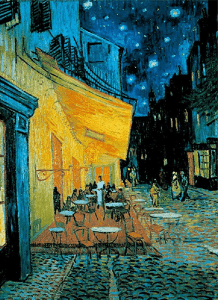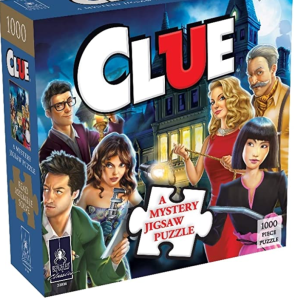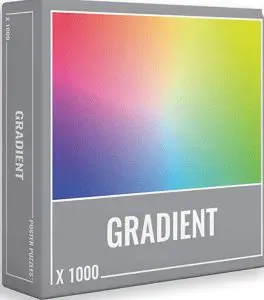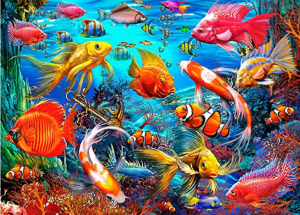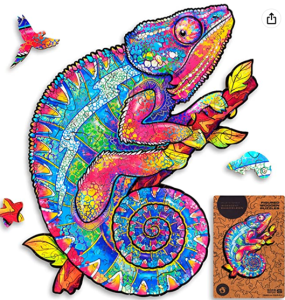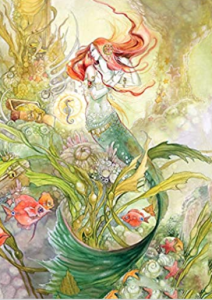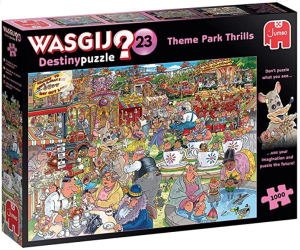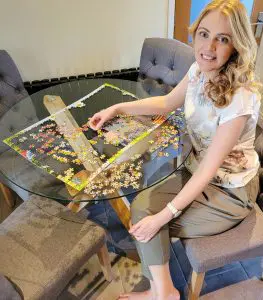 Our love of the jigsaw puzzle came out of nowhere, with our original intention to was simply start a new hobby together and spend less time staring at screens. We borrowed a 500-piece Wasgij and although at times it was frustrating, there is pure joy when you find the right pieces and connect big chunks together.
Our love of the jigsaw puzzle came out of nowhere, with our original intention to was simply start a new hobby together and spend less time staring at screens. We borrowed a 500-piece Wasgij and although at times it was frustrating, there is pure joy when you find the right pieces and connect big chunks together.
We’ve since moved on to 1,000-piece puzzles, which are a little harder, but once you work out the technique you’ll find the process is much easier. It’s crazy how you can intend to spend a couple of hours on your jigsaw and then suddenly four hours have flown by.
It has now become one of our favourite at home bucket list items. If you’re interested in trying out jigsaws, but you haven’t done them since you were a kid then we’re here to help. This is our guide on how to do a large jigsaw puzzle, with our tips and tricks to complete it fast.
Ad Disclaimer!
This website uses paid adverts and affiliate links, these come at no additional cost to you and help us to fund the operation of the website, meaning we can continue to provide you with valuable content.
The money received from these links and adverts do not influence any recommondations made within our content.
Page Contents
Types of Jigsaw Puzzles
So, let’s begin by looking at the various types of jigsaws that you can try.
- Two-dimensional Jigsaw – This is the most common and the one we all think about when we picture a jigsaw. They are a flat 2D puzzle with a picture on the top and blank on the back. You normally find the completed picture on the box, so you have something to refer to if you are struggling. You can find difficult two-dimensional puzzles where the colours are so similar it’s hard to determine the contrasts, for example a jigsaw of baked beans.
- Three-dimensional Jigsaw – Rather than the usual flat surfaced jigsaw, with the 3D option you will finish having created some type of structure. There are so many options for 3D puzzles, but they tend to be famous buildings, animals, or well-known icons such as the Sphinx. For many jigsaw fans they either love or hate this type of puzzle, mainly because it has a different element of difficulty, due to having to be build up and not just across.
- Colouring Jigsaw Puzzles – Now this was a new one to us, but you can actually buy jigsaws which once completed can be coloured in. This can be difficult because you don’t have the coloured outlines to help piece the sections together, but sometimes the fun is due to the fact we find them difficult. Colouring jigsaws are like two hobbies rolled into one, because you have the jigsaw side and then the colouring part (if you’re considering starting a new hobby then check out our (Hobbies Bucket List guide).
- Mystery-solving Jigsaw – For those of you looking for something a little more than just a plain old jigsaw, you may be intrigued to discover another option which adds in the game of Cluedo. Most mystery-solving jigsaws will have you reading the story of a character who has been murdered. You’ll assemble the puzzle which reveals important clues, and then piece the information together to solve the crime. This is a great option if there’s more than one of you putting the puzzle together, because teamwork always makes it easier.
- WASGIJ – So we’ll start off by explaining that WASGIJ is Jigsaw spelt backwards, which ties in a little to what you can expect from the puzzle. There are six WASGIJ themes which vary a little, but the general idea is that the image on the box isn’t what you’re creating with the puzzle. It could be the picture of what the characters on the box are looking at for example. The six themes are.
- Original WASGIJ which as we have mentioned shows you a picture and you have to use your imagination to create a picture of what they are looking at.
- Destiny WASGIJ shows an image from a different period for example the prehistoric age, and you have to create a similar picture of how it would appear in the present.
- Mystery WASGIJ is all around predicting the future because you are shown an image and you have to create a picture of what will happen next to the characters on the box.
- Christmas WASGIJ has the characters on the box staring at something, and by solving this Christmas themed picture, you will put together what they are seeing.
- Imagine WASGIJ is a rare puzzle from the brand, but basically revolves around imagining if something had or hadn’t happened. For example, if the wheel hadn’t been invented, so you’ll see a quirky outcome.
- Back to WASGIJ is a reversal of the Destiny range, so instead of the puzzle being a version of the box in the modern day. It is instead the opposite and reflects a by gone era in the past.
For those of you looking at getting into jigsaws, but you want something a little more exciting then WASGIJ is a great option. This is our preferred jigsaw, and we love the fact that we don’t have an image to look at as we put the pieces together. Instead, we must work it out by colours and patterns, until they start to slot into place. The best part is that WASGIJ puzzles are incredibly comical, and you’ll find there is so much to see in each of them which will make you chuckle.
- Mega Jigsaw Puzzles – We wouldn’t recommend this type of puzzle for the first timers out there. The name mega jigsaw is generally given to puzzles with between ten thousand and twenty thousand pieces. Our first thought was ‘where on earth would we put it’, because most people wouldn’t have a table big enough. When you consider an average jigsaw is between five hundred and one thousand pieces, you can imagine the scale of a mega puzzle. It will take a lot of time and cause a lot of frustration, but the feeling of completing it will be magnified because of the size.
- Digital Puzzles – Now this is a new one for us, but then again, we have only just ventured into the jigsaw world. For those of you who are constantly on the go, but still like the idea of trying a jigsaw, then why not download an app to play a digital version. If you type jigsaw puzzles into your play store, then you’ll see a wide range of options available. You’ll have the pick of the kind of puzzle you want to play and then you’ll be given pieces which you can turn around to see if it slots into place.
- Glow-in-the-dark Jigsaw – If you’ve done a basic jigsaw and you’re looking for something a little different, then why not try one that glows in the dark. They tend to be the standard 2D puzzles, but once you’ve put it all together then you can turn the lights off and watch your jigsaw shine.
- Wooden Jigsaws – This is quite an unusual one, because as well as the normal basic retro jigsaws you will find some incredible artistic options. By Googling wooden jigsaws you’ll be exposed to some breath-taking animal puzzles, which once finished will look beautiful as ornaments in your home. Most wooden jigsaws aren’t basic wooden brown colours either. You will find an array of colourful options making the puzzle more enjoyable to complete.
- Customised or Personalised Jigsaw Puzzle – If you want something a little more personal then you can have a custom-made jigsaw created of a special photograph. It could be a family portrait, a pet or an important moment in your life. You could just have a picture of your face made into a jigsaw and piece that together, because why not!
Tips and Tricks to Assemble a Jigsaw Puzzle
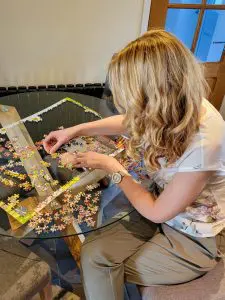 Now you know what jigsaws are available to you, you’ll want to know how to begin and what are the simplest methods to completing your puzzle. At first you will find yourself trying different ways to see what works best. But from our experience, we have found these tips to be the best way to complete your jigsaw fast, with less frustration.
Now you know what jigsaws are available to you, you’ll want to know how to begin and what are the simplest methods to completing your puzzle. At first you will find yourself trying different ways to see what works best. But from our experience, we have found these tips to be the best way to complete your jigsaw fast, with less frustration.
1. Work Out the Best Place to Make Your Jigsaw Puzzle
This is actually more important than you will realise, because to begin with you need enough space on your chosen surface, to fit both the jigsaw and any sections you are working on. But it also needs to be a comfortable spot because you’ll be surprised at how long you will sit there with your puzzle. The hours literally melt away because they are so much fun! We started ours on a table in our living room by the TV, but it meant we had to sit on the floor. As you can imagine after a while it got incredibly uncomfortable. We moved it to our dining room table and that was a whole lot better, we had more space and somewhere comfy to sit.
Most jigsaw puzzles will have the dimensions written on the box, which can help you work out the spot to begin. An important thing to note is that you want to do it on a surface which won’t impede on your daily activities. We have a family member who does their jigsaw on their dining table and then covers it over when they’re eating there. You can get puzzle mats which roll up, a little like a yoga mat, or carriers which are alike a briefcase. But they can be awkward to store away and if the surface is soft, then you’ll find the pieces can be hard to push together.
2. Make Sure Your Lighting is Good
Again, not something most people think about when they start, but jigsaws come in all shapes and colours. Those colours can have very subtle shading, which is why good lighting is essential. This may not be easy if you’re limited by space, so our advice would be to choose comfort over lighting. Of course, you can always bring in more artificial lighting such as a lamp to make the space brighter.
3. Sort and Assemble the Border
You’ve settled in a comfy chair, got yourself a drink and you’re ready to go, so what do you do next and how do you get started. Our top tip would be to start with the border because it is the easiest place to begin. We go through the pieces and pick out any which have a straight edge, meaning they’re part of the border. We’re not going to lie, we have yet to go through the box once and find one hundred percent of the border, normally it takes a few goes. After you’ve pulled the edges out then assemble them on your surface. Pull the four corner pieces out and place them to one side to make the process easier. You will be able to determine how each piece connects by colour, shape, and patterns, and depending on the jigsaw you’ve bought you can simply look at the photo on the box. Obviously, this isn’t applicable to anyone with a WASGIJ jigsaw; with those puzzles simply follow the colours and patterns.
4. Sort Pieces into Groups of Patterns
Once you have assembled the border then you can focus on the centre and sorting out the pieces by patterns. If you’re working from a photo on the box then this will be easier and you can pick out specific colours and patterns, then group them together and try and assemble them in chunks. Working on a small section at a time makes the process much easier and you’ll soon see different groups of jigsaw pieces connecting to make whole areas of the puzzle. Most people will focus on colours because that’s the easiest to group, which is completely fine. But also watch out for the other lines and patterns on the pieces, because sometimes although the colour is right it’s not in the right area or it’s the wrong side.
For those of you with WASGIJ puzzles then follow the same format but try and work out the patterns as you look through the pieces. We pick out wording and patterns on people’s clothes first, because they tend to be significant sections of the jigsaw. You’ll notice that once you have those pieces connected that other colours or patterns will emerge around them. You can then pick those out from the box, or even connect to the edge.
5. Arrange the Rest of the Puzzle Pieces
As we go through the last step of grouping patterns, we tend to move the pieces from one side of the jigsaw box to the other and then back again. As your jigsaw pieces begin to slot into the centre of the puzzle, then you’ll find you have fewer pieces in the box and so you can now turn them all picture side up and have them either still in the box lids, the edges of the table or on a sorting tray. We use the box lids because we can hold them and move around the table and work at different angles because sometimes that helps.
When you’re looking at the rest of the pieces aim for certain colours, shapes, or patterns to try and connect them to the already fitted jigsaw. The shape of the jigsaw piece will have the most impact on whether it fits, on most there are inner bits which are known as innies, hooks, sockets and holes, or outer bits known as tabs, knobs, outies, loops. Many times we have been sure the pattern and colours match up, but those darned hooks and knobs just don’t seem to fit.
6. Pick Out the Odd Pieces
As the pieces start to dwindle down and you’re seeing more of the centre of the jigsaw fill up, this is the time to start separating the odd pieces. But what exactly do we mean by odd pieces. The majority of your jigsaw pieces will have two knobs opposite each other and two hooks the same.
Then you will have a variety of other odd pieces for example one knob and 3 hooks. At this stage we separate everything aside from the standard pieces and put them to one side. As the jigsaw fills up you will see areas where its an odd piece, so you can quickly look through the few that are left and work out which one it is.
7. Keep Looking at the Pieces!
Jigsaws come in a variety of difficulty levels and it can feel frustrating in the early stages, especially when you’re trying to gather the patterns. Our advice for those times is to walk away and come back to it another day when you’re fresh and ready to start again. Then relook at the patterns and see if you can group them together and attach it to the centre of the puzzle.
Remember it’s all about enjoyment, and even though you can feel annoyed at times, once a piece slots in there’s a real thrill which makes it worthwhile. You’ll find that the more jigsaws you try, the easier the overall process and quicker it will take to complete them.
The pieces should be tight when they connect so watch out for any gaps, colour, and pattern mismatches, or high or low points as this could be a misplaced piece.
How Long Does It Take to Complete a Jigsaw
This isn’t an easy question to answer because there are a number of factors. How big is the jigsaw, how complex is it and how many jigsaws have you completed. On average for a 1,000-piece jigsaw you’re looking at 7 to 10 hours as a beginner, but the more you finish the faster the time because you will have picked up techniques to make it easier. We tend to spread that time out over a few evenings because it makes it more enjoyable and less of a chore. Also taking some time away and having a fresh look at it, can give you a new perspective on pieces you’ve looked at a hundred times already.
Framing Your Jigsaw
Once you’ve completed your jigsaw you can either pull it apart, or why not consider framing the puzzle and putting it on your wall as art. This option is becoming popular as more adults are taking up jigsaws. Make sure you research the correct technique on gluing your puzzle, because using brushes for the glue can leave stroke marks behind. We haven’t framed any of our jigsaws, but we have friends who have, and the results are beautiful.
Our Favourite 1,000 Piece Jigsaw Puzzles
WASGIJ, Original 32 – The Big Weigh In!
We love the surprise picture of this puzzle, because as well as being fun to put together the outcome is incredibly funny.
HUADADA, Northern Lights in Norway
You’ll enjoy this jigsaw because it is a bit of a challenge, having large similar patterned sections. But once completed it is a beautiful image of the Northern Lights in Norway.
DOUBLETOP, Vincent Van Gogh Café Terrace at Night
This famous painting is the ideal jigsaw for those of you looking to frame your puzzle. There are lots of intricate patterns and shading which makes it fun to do.
University Games, Cluedo Mystery
The perfect way to step into the mystery jigsaw genre because who doesn’t love Cluedo? You’ll read the story and then assemble the puzzle and try to work out who is the murderer.
Something a little harder, so may not be the first puzzle you complete. This colourful jigsaw is a great way to challenge yourself if you’re a bit of a puzzle nerd.
If you’re looking for a serene and beautiful jigsaw puzzle, then this is the one for you. Lots of great patterns and colours make this a great first puzzle to complete.
UNIDRAGON, Iridescent Chameleon Wooden Jigsaw
This beautiful wooden jigsaw has unique shaped pieces of animals, plants, and birds, which create a colourful chameleon.
HUADADA, Hot Air Balloon Jigsaw
We love the colours and shapes throughout this beautiful jigsaw, and it’s a great option for newbies due to the various clusters of patterns.
This amazing jigsaw is more a work of art than a puzzle, with incredible pastel colours. It will be quite a soothing puzzle to complete, instead of the busyness of some of the other options.
We started with WASGIJ, so we may as well end with them because they’re brilliant puzzles. The destiny range takes you into the future from the puzzle you’re seeing, and this hilarious theme park jigsaw has some funny futuristic outcomes.
We’ve explained the types of jigsaws available, our tips and tricks on completing it fast and even provided you with some of our favourites. So, you should be ready to get going once you’ve purchased your puzzle.
For us, jigsaws began as a low cost bucket list hobby, so we spent some time together that didn’t involve staring at a TV screen. We had no idea how much we would enjoy it, and the fun it would bring to our lives. We’ve even got family members involved and it’s been a great way to connect with them as we discuss how difficult various puzzles are.
The best part of jigsaws is that they are ideal for any time of year, so you can add them to your summer bucket list or winter bucket list. Also, when you compare them to most other hobbies, they are really inexpensive, and you can swop jigsaws with other friends and family who are avid puzzle fans.
If all of this isn’t great enough, you’re also improving brain function because working on a puzzle reinforces connections between brain cells, improves mental speed, concentration, and short-term memory.
For those of you reading this and you’re not sure if you can do a jigsaw, then our advice would be to start with a 500 piece initially and then build up. You’ll find that you create your own steps as you do each puzzle, because you have worked out ways to complete it faster. But hopefully the tips we have provided will be a good starting point for you.
If you add any pictures of your completed jigsaws to Instagram, then please tag us in. As you can guess we have become a little nutty about them, so we’re excited to see what our readers have accomplished.


